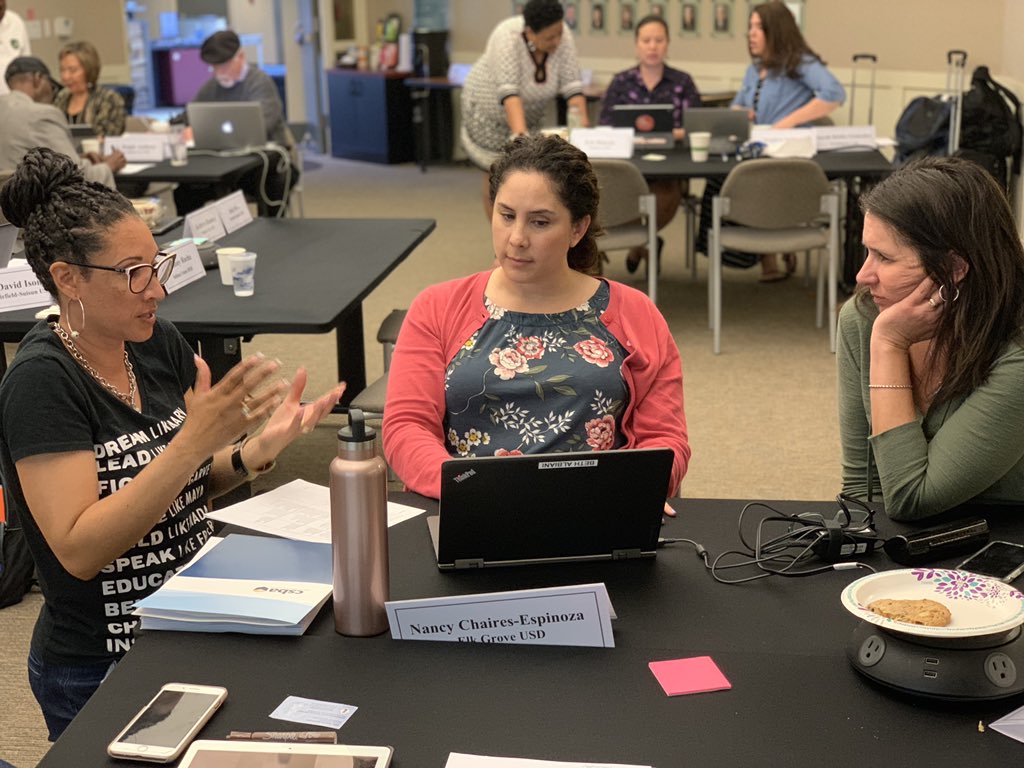By Nicole Anderson
In light of recent events in our nation that have sparked a global movement, school districts around California have begun to take bold and courageous steps to combat institutional racism. Governance teams have released statements to their communities expressing solidarity with Black Lives Matter as well as committed to reopening, or should we say, “reimagining” schools with intentionality to address equity gaps that were exacerbated during distance learning for many students. And while experiencing an immense amount of pressure to address the health and safety of students in light of COVID-19, governance teams have also grappled with the challenge of redefining instruction and grading systems while still wrestling with the ever-looming impact of institutional racism. This is truly an unprecedented time in education in which school board members must consider what side of history they will be on when addressing racial equity gaps at the policy level.
Educational data continues to reveal numerous equity gaps, including opportunity and access gaps that have historically persisted for students of color; specifically, African American and Latinx. One factor to reflect upon is the persistent failure of policymakers at the federal, state and local levels to act on this evidence, which has resulted in the continued predictability of educational success or failure based on these ethnic as well as socio-economic factors. Taking action requires redefining student success through multiple measures in place of historically biased metrics (i.e. standardized testing) rooted in eugenicist theory — the belief about genetic inferiority based on racial characteristics — where educators have been misguided in their equity-focused work. Ultimately, the moral imperative facing school board members today requires an intentional commitment, both personally and professionally, to equity-driven governance practices that prioritize educational equity for historically underserved students. This includes the need to develop an assets-based mindset with the high expectation that students of color can learn through their unique gifts, talents and interests.
Recognizing barriers of institutional racism
As governance teams lock arms with their superintendents to become more united in their vision and shared beliefs around educational equity, it is imperative that safe space be fostered for continuous learning and trust-building in order to take a deeper dive into the discomfort of addressing institutional racism. This includes being self reflective in moving toward effective governance practices, as illustrated by the Center for Public Education report “Eight characteristics of effective school boards.” The journey to combatting institutional racism must begin with dismantling internal barriers that may impede the work. External barriers to closing racial equity gaps must be unpacked as well and include many factors, such as historical policies and legislation, resistance to change, privilege, entitlement, implicit bias, stereotypes and, most detrimentally, a lack of awareness for the need to change.
To interrupt systemic inequities that impact education, it is important to understand the context of these barriers. In Structural Racism and Community Building, a June 2004 publication from the Aspen Institute Roundtable on Community Change, institutional racism is referred to as the policies and practices within and across institutions that, intentionally or not, produce outcomes that chronically favor, or put a racial group at a disadvantage. Examples of institutional racism in the educational landscape can be found in school disciplinary policies in which students of color are punished at much higher rates that their white peers or in the hiring process, where recruitment and retention practices yield disproportionate ethnic representation of staff in comparison to students. Structural or systemic racism refers to a system in which public policies, institutional practices, cultural representations and other norms work in various, often reinforcing ways to perpetuate racial group inequity. It identifies dimensions of our history and culture that have allowed privileges associated with “whiteness” and disadvantages associated with “color” to endure and adapt over time. Structural racism is not something that a few people or institutions choose to practice. Instead, it has been a feature of the social, economic and political systems on which our nation was built.
Responding to the barriers of institutional racism
To dismantle or interrupt a system like education that wasn’t designed to yield equitable outcomes for all students, governance teams must recognize the various conditions in the system that are holding the inequities in place. As illustrated in the “Water of Systems Change” article by Peter Senge, Mark Kramer and John Kania, there are six conditions in a system that must be addressed in order to realize lasting change — in this case, educational equity. While governance teams primarily operate at the policy level, it is important to access and address institutional racism by focusing on the explicit conditions (policy, practices and resource flow), the semi-explicit conditions (relationships and power dynamics), as well as the implicit conditions (mental models). While these conditions are interdependent, they all have great impact in the realization of lasting system change for racial equity in education.
Examples of strategies that school boards have explored to systemically address racial inequities include but are not limited to the following:
- Cultivating a culture of learning, collaboration and trust among the governance team, where discomfort is embraced as a lever for transparent and proactive change.
- Adopting an equity statement to articulate a common vision and commitment to the work of the district.
- Adopting an equity policy that provides clear guidance on how the school board will govern all aspects of the district with an equity lens.
- Adopting an equity impact plan/strategic plan to focus and prioritize monitoring the impact and implementation of the Local Control and Accountability Plan for target student groups.
- Asking meaningful questions of the superintendent and staff that align with the district’s collective purpose and focus on educational equity.
- Allocating and prioritizing the district budget to reflect its values about equity through ongoing professional learning for all district staff with an explicit focus on racial equity across all aspects of education (i.e. curriculum adoption, instruction, discipline, etc.).
- Empowering community and student voices through listening sessions around policing in schools.
- Utilizing equity advisory groups with diverse representation across the district.
- Engaging in ongoing study sessions to prioritize and unpack equity challenges.
- Engaging in equity walks across the district campuses to understand the context of equity in action.
- Partnering with local agencies to address community equity challenges such as redefining relationships with school police.
- Employing explicit policies and protocols around addressing challenges such as racially motivated behavior by students, staff or community members.
- Adopting policy that supports the strategic implementation of research-based practices around culturally relevant instruction, ethnic studies and social-emotional learning.
- Participating in county school board networks to foster a collaborative movement in replicating and sustaining promising practices.
- Hiring a superintendent who is equity-minded and intentional about the implementation of anti-racist practices.
Realizing racial equity in a district includes a shift in resources where the fair distribution of benefits and burdens are not skewed by race and ethnicity. It demands that we pay attention not just to individual-level discrimination, but to overall social outcomes of the school community. While we must avoid engaging a focus on “oppression olympics,” it is important that we acknowledge the pain and impact of oppression for all historically marginalized groups. In this, we must also be even more courageous to recognize our power and ability to interrupt institutional racism, even when it creates a space of discomfort. Ultimately, everyone benefits when racial equity gaps are closed. After all, racism harms everyone.
Equity leaders, we cannot close the educational gaps that we see in our schools if we don’t close the one in our minds first.





